When I was a child, I found a fairy wing under a dogwood tree. Delicate and transparent, it lay on the rough surface of a rock, the wing’s form made distinct by veins a pale, bright blue with a hint of green; in my crayon box, this color was called “aquamarine.” As the veins stretched from the wing’s tapered based to curved edge, they dulled and darkened to gray a shade darker than the rock. Like the metal borders between sections of stained glass, the veins traced the edges of wing cells. Clear as windows but thin as paper, the translucent surface of these cells bent and rippled into small curves that reflected light. Sunlight fell from the sky down on me and the fairy wing, passing through the dogwood leaves, and turned cloudy white as it touched the waves in the fallen fairy wing.
I kept the wing. I brought it inside to keep with a collection of similar objects — pressed leaves and flowers, found feathers, interesting rocks. Eventually I admitted to myself that it was not a fairy’s wing, but a dragonfly’s.
But I was wrong.
Both times, I was wrong. The wing had fallen from an insect’s body, but unlike the illustrations of fairies I’d seen, that insect is neither slender nor graceful. Between luminous glassy wings, the insect’s body is stout, squat, and round, with a flat face that seems to be permanently fixed in a goofy smile, with bulging eyes on either side; its flight is loud, brief, and clumsy. The creature with wings like a fairy’s is the cicada.
Cicadas (Superfamily Cicadoidea) belong to the insect order Hemiptera — “true bugs” — along with stinkbugs, assassin bugs, and the planthoppers featured in the last two posts — tiny bugs often with brightly colored shapes and patterns on their wings. Cicadas fill each summer with song — crescendos of clicks, buzzes, rattles, and electric zaps — and sometimes leave behind bug-shaped sculptures, perfect replicas of themselves, pale brown and semi-transparent like amber glass. These exuviae are the result of their final molt from soil-dwelling nymph to tree-climbing adult. Hemipterans, like grasshoppers and dragonflies, undergo incomplete metamorphosis. They do not begin life as a larva, as butterflies and beetles do, but as nymphs. Nymphs grow, undergo ecdysis (molting) a few times, and, with their final molt, become an adult. Particularly as they approach their last molt, nymphs somewhat resemble the adults of their species. A grasshopper nymph, for example, is recognizable as a grasshopper, whereas a butterfly larva — a caterpillar — looks less like a butterfly and more like a colorful worm with feet.
After this final molt, the cicada’s body is bright and soft; this stage is called “teneral.” In this state, they are practically defenseless, so they typically emerge and molt at night. Yet I once observed a Northern dusk-singing cicada (Megaticiben grossa) emerge on a Sunday morning, perhaps fooled by a large tree’s shade into thinking it was night. Clinging to a crumpled exuvia, the claws of which were clinging to the side of a garden bench, hung a bright green creature with pale, rose-colored eyes. Folded over its body were a pair of wings — their color a verdigris gradient of sea green to aqua to cerulean. As I watched, the cicada turned a darker, duller, earthy green, the face darkened further to dusty gray-brown, and the wings faded, soon fully transparent with only the veins retaining some shade of blue-green.
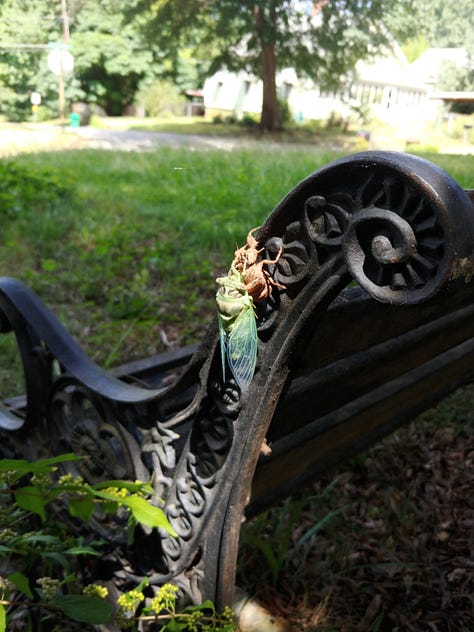
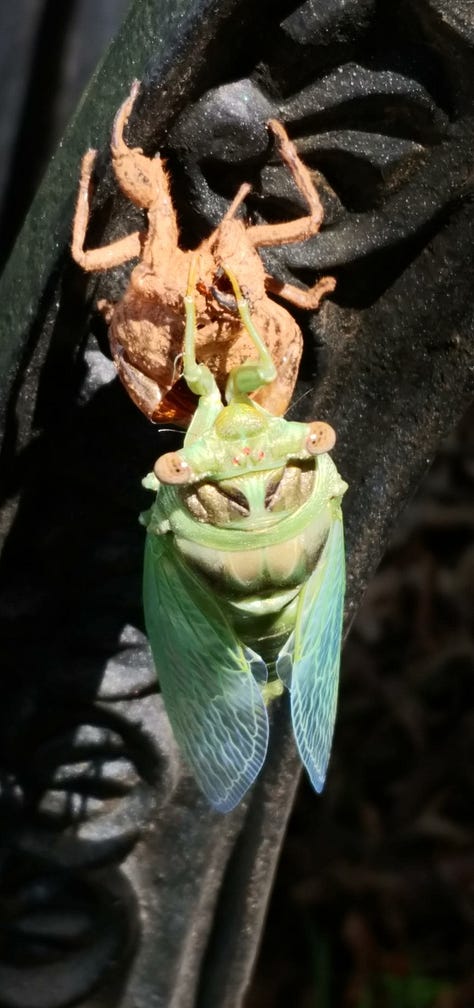
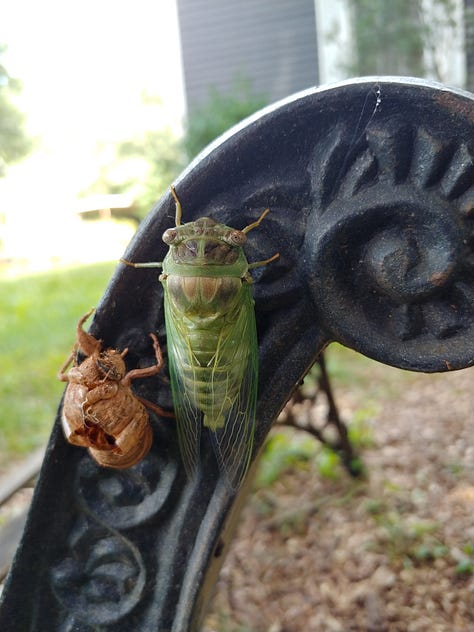
Cicadas begin life above ground — as eggs laid in trees and hatched as first instar nymphs who promptly descend into earth. There, they feed on the sap of tree roots and molt until they are ready to emerge, to rejoin the life above. For the remainder of their lives, they feed on plant sap — rarely harming the plants in the process — mate, lay eggs, and die, decomposing into the soil and providing nutrients for the plants upon which they fed — returning to the earth, while their newly hatched young also travel to the earth, to feed and grow and eventually re-emerge, repeating the cycle again.
The many species of annual or “dog day” cicadas in the Southeast live underground as nymphs for a year or even several years, emerging based on factors such as temperature and moisture. Many of these species do not synchronize their emergence; individuals emerge from the soil on their own time. Other species synchronize their emergence based not on a set period of time, but on environmental factors such as rainfall. One genus of Southeastern cicadas emerges with predictable synchronization — the Magicicada, or periodical cicadas. Large groups of Magicicada live underground for thirteen or seventeen years, emerging en masse in spring, filling the air with a shockingly loud chorus for weeks as they climb trees, feed on plant sap, mate, lay eggs, and die — falling to the earth where they spent most of their lives, decomposing and giving nutrients to that earth, to the trees that helped give them life, whose roots will support their offspring during the decade plus that those nymphs live, feed, and grow underground.
Magicicada also differ from our annual cicadas in appearance. The latter tend to be blue-green, gray, gray-blue, brown, and brown-green, these colors appearing in patches and patterns, like camouflage. Magicicada lack these ornate patterns but make up for it with their striking shades in a Halloween palette — their bodies uninterrupted obsidian but for minor marigold markings, wings veined with that same marigold orange, giving their glassy wings a golden cast, and their round eyes the bright red of a male summer tanager.
Memorial Day 2021 found me not at a barbecue, but in my car, traveling on Woodring Branch Road toward the Amadahy Trail at Carter’s Lake, where Brood X periodical cicadas had been reported. I paused my audiobook and opened the car window. Sound rushed in — not the clicking and buzzing of the cicadas I was accustomed to, but a high-pitched drone, similar to the voice and tone of emergency sirens as though heard in the distance, with the white noise of many fans in between. The chorus held a single, sustained note, though occasionally one singer would break from the group and sing a solo — two notes, back and forth, like a distant siren. I’d read complaints on Facebook about this noise for weeks, but hearing it, I smiled. It was my first experience with periodical cicadas.
I parked at the trailhead and walked into the woods, my eyes scanning for big bugs with red eyes. Lying on the leaf litter was a single wing, the slender leaf shape of a fairy’s wing, shimmering like rippled glass as waves in the wing cells caught the sunlight that slipped through gaps in the forest canopy. The veins that traced the borders of wing cells were the color of daylilies — the wild orange ones that appear on roadsides throughout the state. The wing belonged to a Magicicada.
I found cicada exuviae attached to trees, whole cicadas clumsily clambering over the forest floor, cicada corpses on a wooden bridge, and by the time I completed the 3.6 mile loop back to my car, a slow-moving cicada in the parking lot that I painstakingly shooed into the woods, out of the path of cars. When I added the photos to iNaturalist, I was shocked and disappointed to see many of my Magicicada septendecim observations downgraded to genus — Magicicada sp. I hadn’t realized more than one species of seventeen-year cicada existed, let alone how to tell them apart. I hadn’t thought to pick any up, turn them over, and photograph their abdomens. Only a few photos were identifiable as M. septendecim, because of the bright orange patch behind the bugs’ red eyes.
Seven species of Magicicada exist, six of them in Georgia, in three groups that all descended from a common ancestor.1 These three groups—Decim, Decula, and Cassini— evolved from that common ancestor and then each independently evolved into both thirteen- and seventeen-year species; in the case of the Decim group, there are two thirteen-year species.2 These specific numbers — thirteen and seventeen — may have provided an evolutionary advantage because they are prime numbers, so that the synchronized mass emergence of each brood does not match the timing of any predator’s life cycle — but since all species of cicada must contend with predation, this hypothesis may be incorrect.3 There does not appear to be a solid theory as to why all seven species of Magicicada both synchronize their emergence with others of their species and spend such a lengthy, prime number of years underground as nymphs.
In 2021, when I sought Brood X, I might have encountered Magicicada septendecula and M. cassini in addition to the M. septendecim I heard and photographed. When periodical cicadas returned to Georgia in 2038, I would be more careful.
Fortunately, I did not have to wait that long; three years later, the Great Southern Brood of thirteen-year-cicadas arrived, filling much more of Georgia — and North America — with noise.
To hear the sound described in the text (and inserted into the voiceover narration), click play. It is a recording of the Brood X Magicicada septendecim at the Amadahy Trail on May 31, 2021.
I highly recommend The Cicadas of North America, beautifully written and illustrated by Chris Alice Kratzer of Owlfly Publishing. I cracked open this impressive tome to refresh my memory on terminology and found myself drawn into the introduction; moments later I thought, “Has a field guide just moved me to tears!?” Each time I open the book to check some specific term or fact, I find myself drawn to the pages I intend to flip through; each time, I learn a new fascinating fact. If you have any interest in cicadas or in well-crafted prose that is also full of facts, I highly recommend this book. Order it here.
T. Sota, S. Yamamoto, J.R. Cooley, K.B.R. Hill, C. Simon, & J. Yoshimura, Independent divergence of 13- and 17-y life cycles among three periodical cicada lineages, Proc. Natl. Acad. Sci. U.S.A. 110 (17) 6919-6924, https://doi.org/10.1073/pnas.1220060110 (2013) (Abstract); “General Periodical Cicada Information,” Periodical Cicada Information Pages, University of Connecticut, https://cicadas.uconn.edu/general_information/.
Sota, et al., supra fn. 1.
"General Periodical Cicada Information,” supra fn. 1.



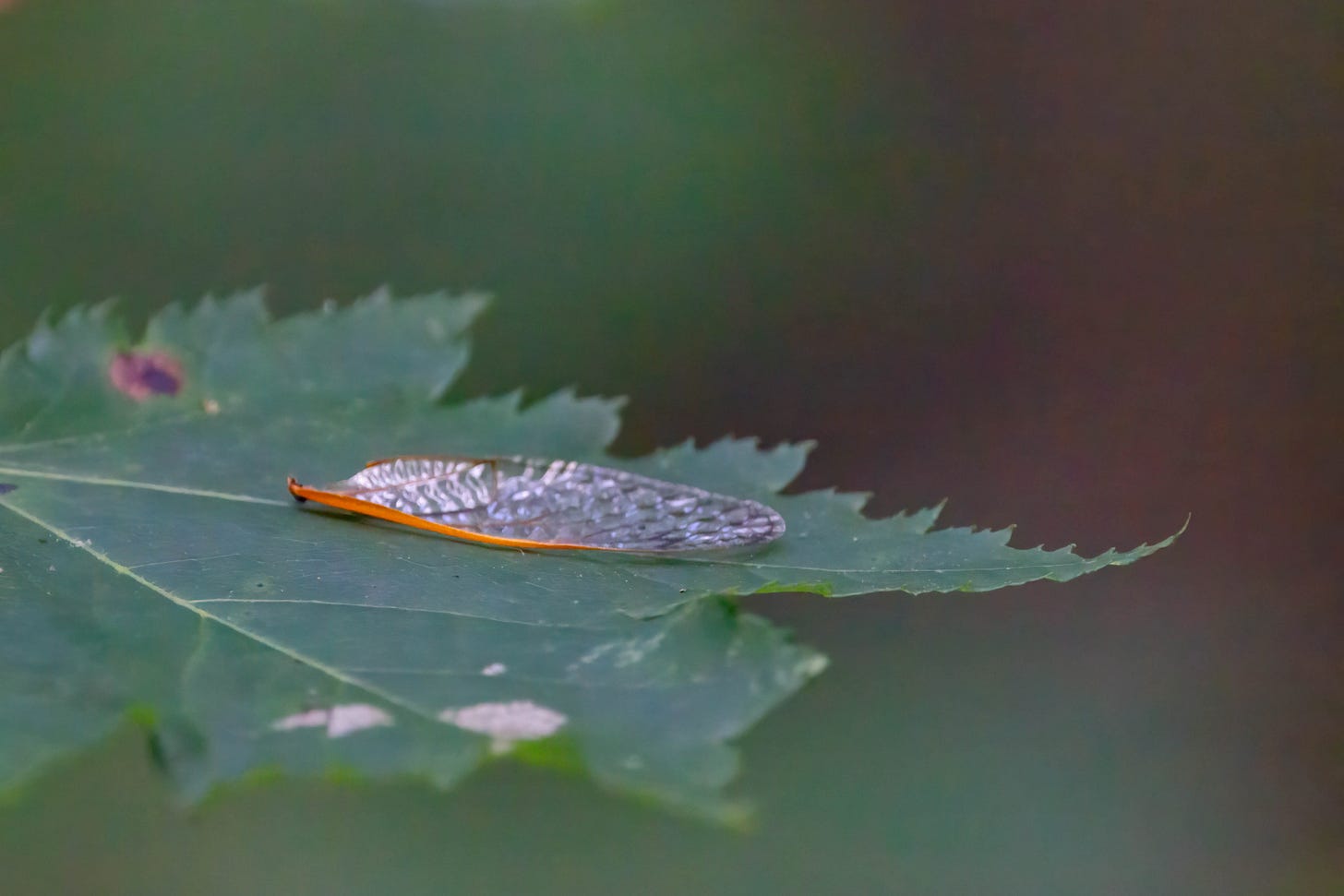
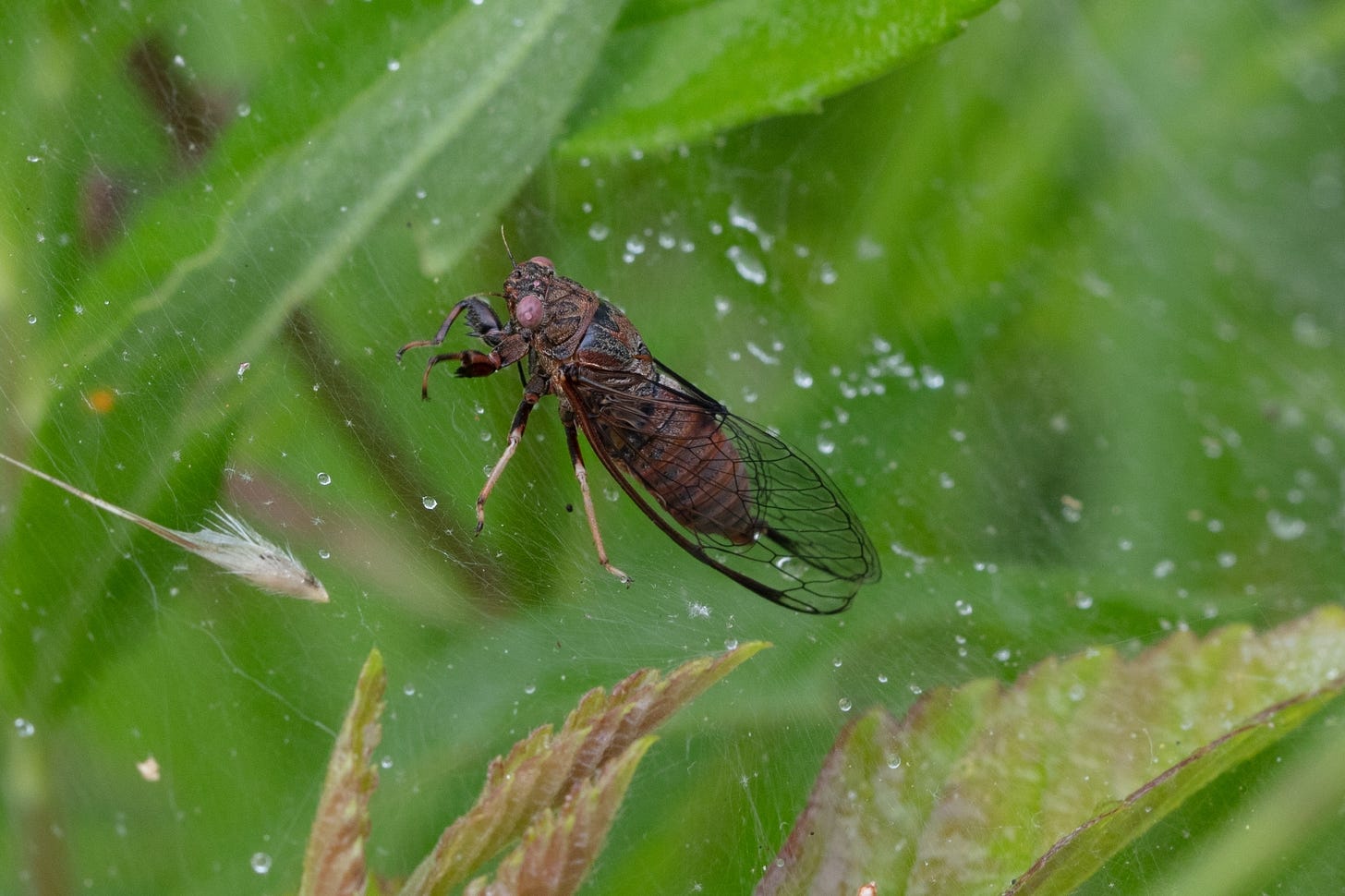
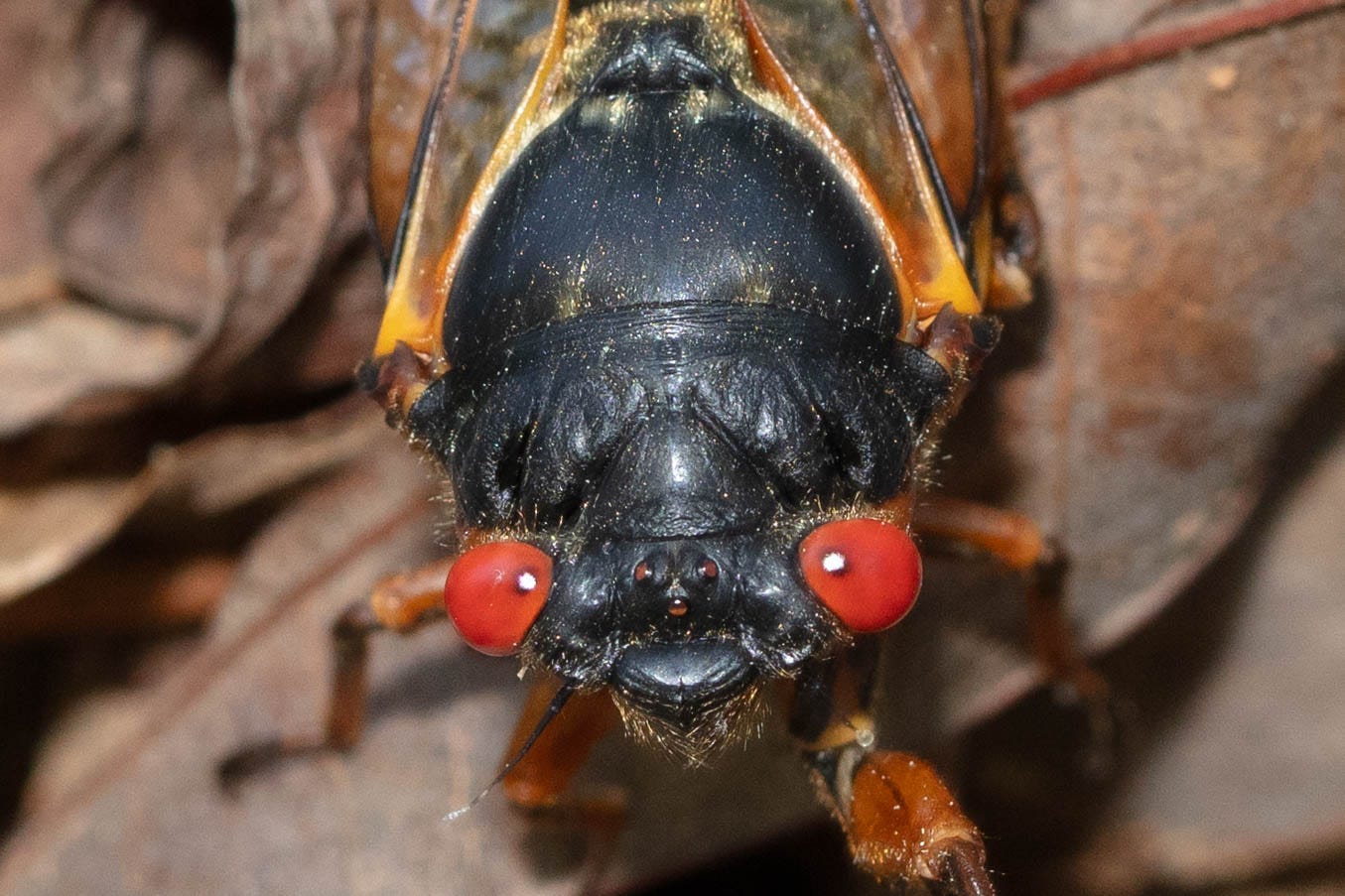
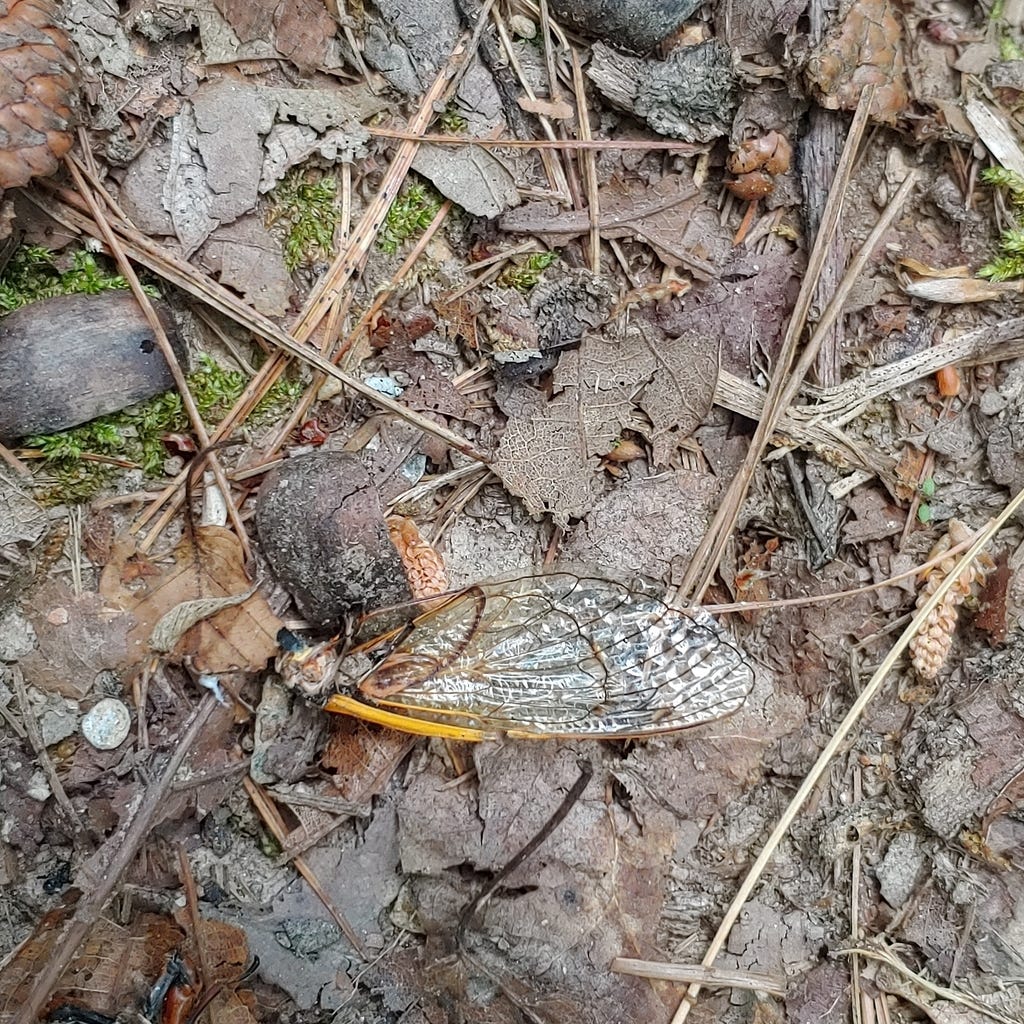
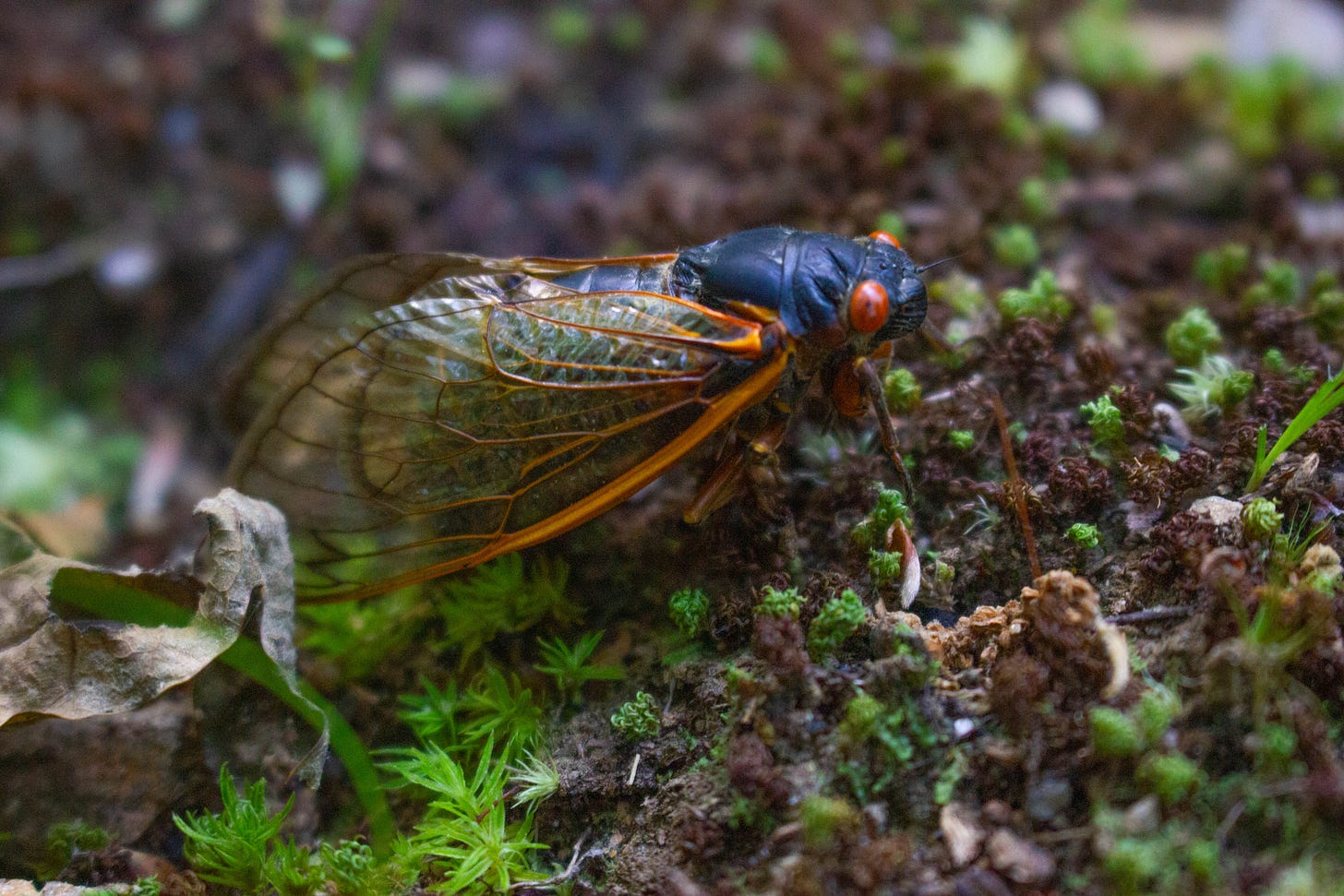
Cicadas are so magical - I tried sneaking up on one the other day, to see if I could get a closer look, but it flew away. Scared me half to death haha, the adrenaline omg 😅😅 I do enjoy finding their casings randomly stuck to things. It’s such a fun surprise, to find them out & about!
Love this, especially the beginning. I also have a cicada wing, kept in an earthenware bowl of various things I've pocketed over the years ... buckeyes, shells, a hag stone, coral and feathers.